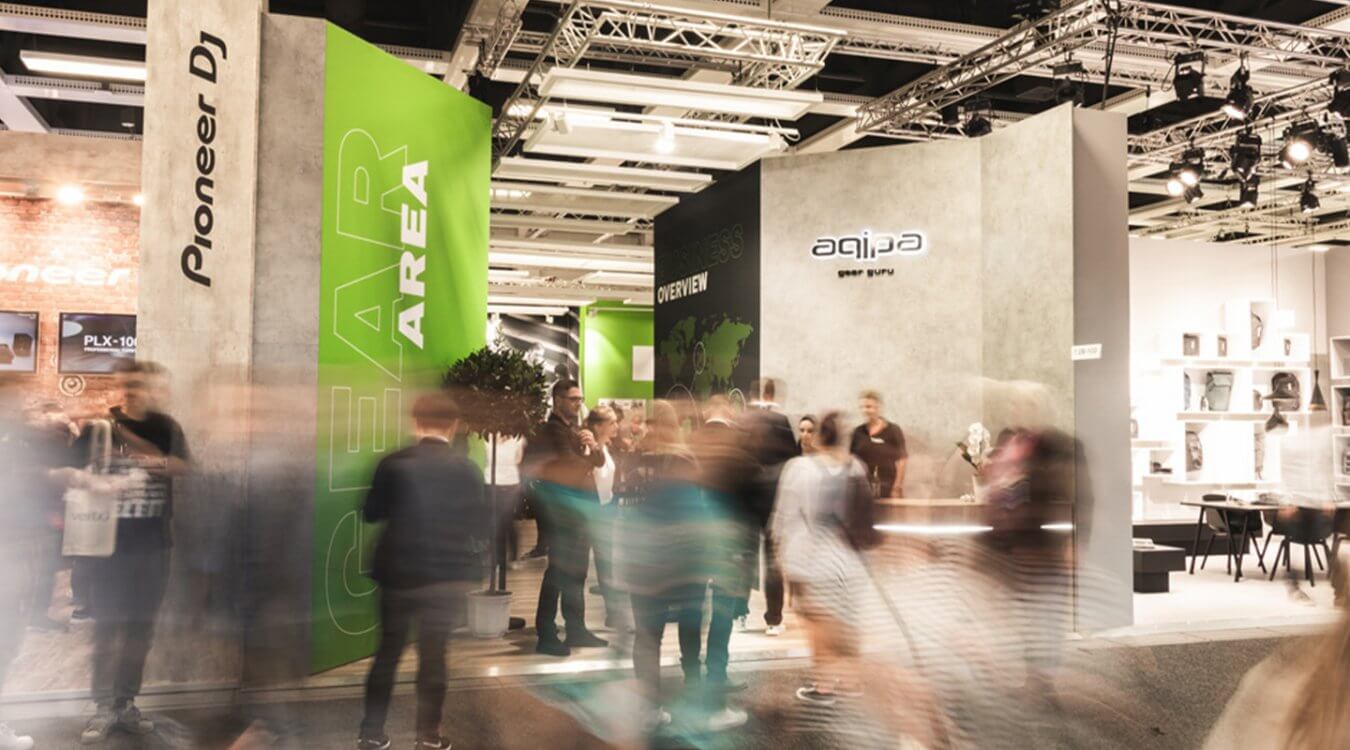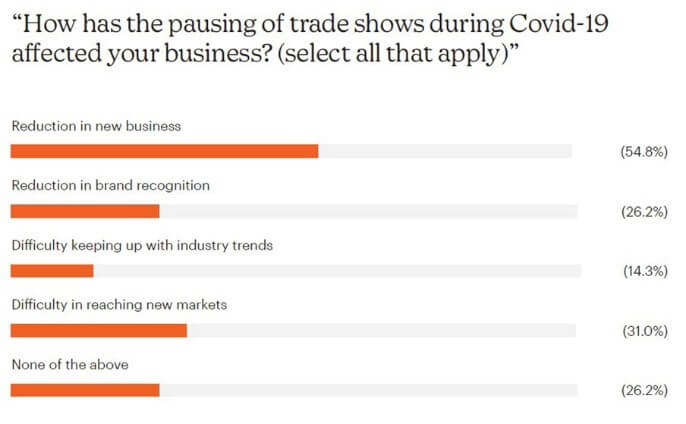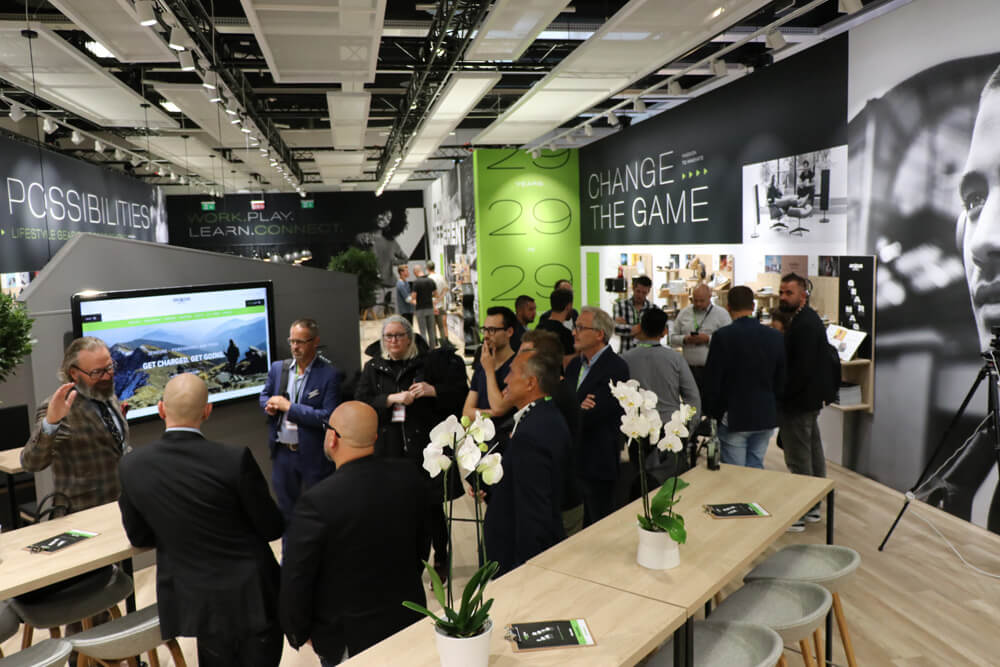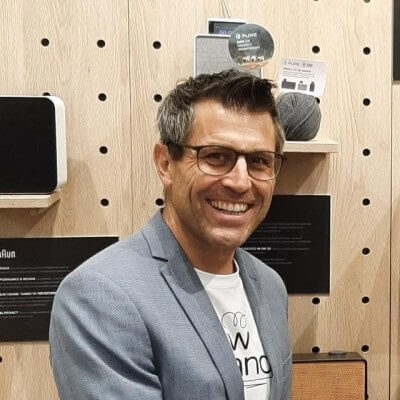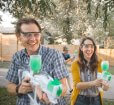The trade show positioning problem
…and why we’re returning to IFA anyway
“One time at IFA. I’d walked until my feet were sore, and there wasn’t really anything new to see. But then, by chance, I met Max at the hotel check-in. We’d lost touch over the years, but now he’s working for this cool new brand. Some dope ass s… they’re doing. Just what we’re looking for! So cool I could fix a deal right there at the trade show. Personal connections – that’s what it’s all about!“
Well, unfortunately we won’t be meeting in any hotels at IFA this year. Still, we have learned that there is something virtual events can’t replace: chance encounters. The “quick drop-bys”. The “showings and testings“. The „I’ll-come-by-when-I-have-time-meetings”.
Home delivery is where it’s at these days. Not just in retail. That’s why we will pay you a visit. Right on your doorstep. For a whole day. We’ll ComeOnOver!
This was the introduction of our winning pitch for the German Brand Award, and it sums up nicely the advantages and challenges of trade shows. Our head of marketing Hubert Eiter will now dissect these challenges, provide some food for thought and tell you why we as a pan-European growth accelerator for premium consumer brands will return to Europe’s largest CE trade show, IFA 2022 in Berlin.
The Facts
Let’s start with some facts. Why should you even bother reading this? According to a study from 2018 and US data, the average B2B business allocated a whopping 40% (!) of their annual marketing budget on trades shows! In absolute terms, that accounts to a median spend of 20k USD per show, and we all know that the cost rises with the amount of visitors.
Booth spendings of a few 100k or more are not seldom, and if travel costs, promotions, giveaways etc. are taken into account, the average cost for a trade show rises to 75,000 USD or 20 USD per verified visitor (not lead). Another key finding in this study is the relationship between the size/popularity of the trade show and the associated expenditures.
Even though companies spend upwards of 30-40% of their yearly marketing budgets on trade shows, 15% of respondents claim they don’t think the shows are effective. “In my experience I have seen very few organizations where trade shows were managed according to pre-set goals and objectives that were agreed by marketing and sales,” says Hubert. “Afterwards, it’s always easy to say ‘It was a good show’ if you have not defined BEFORE what ‘good’ means to your organization.”
Answering these questions can help manage expectations:
- How many new leads are you expecting?
- How many existing customers will you speak to and how many new listings with new products do you expect 3-6 months after the show?
- What is the number of new email-sign ups and registered visitors you are expecting?
- What’s the business expectation from these new leads 3 -6 months after the show?
- What is your conversion target?
- What is your expected cost per identified visitor? What is your expected cost per lead? Per existing customer?
Note that it is not about collecting these numbers only. The KEY is really to define the TARGET before the shows – otherwise, how will you know whether 5 or 13 or 70 converted customers is a good number? Setting exact goals and making teams commit to them is not easy, but it helps immensely with the understanding of what a good trade show is, which makes assessing the ROI much easier as well.
The Impact
Since trade shows are costly and hard to measure, why should we even bother having them you might wonder. Here’s a few reasons:
- 82% of trade show attendees have buying authority (source: Excalibur Exhibits)
- 74% of attendees believe engaging with exhibitors makes it more likely for them to actually buy the displayed products/services (Hill & Partners)
- Trade show attendees will tell more than six people about their event experience (Graphicolor Exhibits)
- 55% of event marketers saw a reduction in new business acquisitions due to the pandemic-related trade show hiatus (Display Wizard)
- 95% of exhibitors prefer face-to-face interactions to virtual substitutes (Display Wizard)
- 88% of businesses participate in trade shows to raise awareness for their brand (Spingo)
- 85% of exhibitors’ trade show success depends on on-site staff performance (Highway 85 Creative)
- Converting a trade show lead costs 38% less than doing the same via sales calls alone (Convention Data Services)
- 79% of attendees say trade shows help them decide what to buy (Graphicolor Exhibits)
The Problem
Taking all this research into consideration, Hubert defined 5 key reasons people attend trade shows:
- Networking and nurturing relationships with existing customers
- Evaluating the competition and increasing awareness
- Demonstrating new products and services
- Meeting potential new customers
- Learning about the latest trends and industry insights
When was the last time you bought a product that wanted to be best-in-class in 5 different use cases? Positioning is one of the most critical problems trade shows and, by extension, exhibitors face today. We want to have it all, which leads to unclear messaging, high costs, ever increasing floor spaces and subpar results in each of these categories.
Food for thought
We’re constantly working on our product messaging to make it as simple and clear as possible, but for this to work better, trade shows would have to make adjustments to their culture as well – for instance by being more flexible in terms of sacrificing certain display components to make room for optimising others. A streamlining pilot could look as follows:
The Networking Show: INTRIGUE
Objective
- Meet as many existing customers as possible
- Sit down with them, chat and nurture the relationship
Implementation
- Get rid of expensive booth designs and displays
- Operate under one motto in an atmospheric setup
- Build a piazza to meet and stroll
- Focus on the best possible meeting experience for customers
- Eliminate uncomfortable, dull-looking chairs pre-packaged food
- Offer special culinary delights and drinks
- Let companies focus on invitation management
- Get rid of product demos and provide interesting presentation formats instead
The Product Show: EXPERIENCE
Objective
- See and experience as many products as possible
- Really understand the different value propositions and strengths
Implementation (for audio)
- Install standardised listening rooms and have products compete head-to-head in blind auditions
- Let buyers vote and compare their blind results with their personal preferences
- Allow only brands that have something exciting and new to tell
- Have brands apply for a limited number of spots to filter out those worth the experience
- Build different consumer scenarios (outdoors, kitchen, living room, bathroom etc in different styles, from minimalist to eclectic to traditional to country etc) and install products from different brands in them
The Trendspotting Show: LEARN
Objective
- Discover new challenger brands
- Establish cross-fertilisation and brand partnerships
- Spot new trends and technologies
- Connect with other industries
Implementation
- Combine a fashion with an electronics and furniture show to observe trends in each sector
- Inspire and get inspired
- Invite insiders and outsiders to present and host talks/discussions
- Offer off-site events with inspirational table captains that unite groups with different backgrounds under a common theme
The Dating Show: DEVELOP
Objective (for brands)
- For brands to bag new distribution partners and retailers
Implementation
- Allow only brands that are not part of GFK data to participate
- Have brands pitch to make sure they are relevant
- Install speed dating tables or turning wheels to make sure buyers and distributors see a lot of different brands
- Focus on 90-second pitches and personal connection
- Plan themed evening events to further fresh relationships
- Build Tinder for trade shows
The Conclusion
When it comes to the suggestions above, trade shows tend to try to be a little bit of everything, which often clashes with expectations. Drawing from years and years of marketing and trade show experience, Hubert advocates a one-aspect-focus to bring more efficiency, fun and lucrativeness to the trade show experience.
So, why are we returning to IFA? We want to use this year to focus on the networking aspect of the show. One of the biggest problems we faced during the pandemic was the absence of personal connections. The lack of chance encounters and spur-of-the-moment discussions. That’s why Aqipa will return to IFA with a networking area that is both fun and functional. We are extending this service to partner brands that want to meet with their contacts and will be providing some awesome treats:
- Food and beverages: From coffee made by our very own barista to tasty culinary highlights to a range of exciting drinks from around the world.
- Entertainment: We’ll be presenting the winning artists of our vinyl contest with TEAC and gigmit.
- Goodies: Our high-quality gifts, memorable swag and unique giveaways will drive more traffic to our booth and stay with visitors even after they leave.
- Team access: Our entire sales team will be in Berlin because 85% of an exhibitor’s trade show success depends on staff performance if you remember. We also know that sales reps are the best booth assets.
- A lot to talk about: More than a dozen brands in one place – both novelties and old-time favourites with new products.
ZONE IN and meet us at IFA, booth 220, Hall 1.2. You can book an appointment here.
